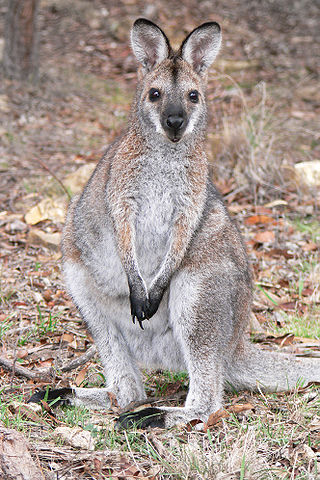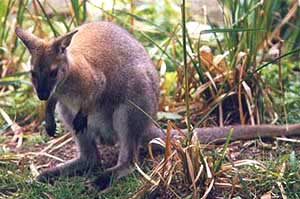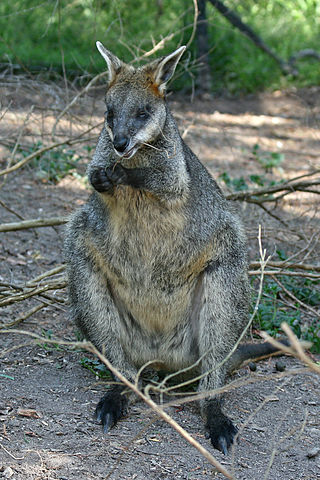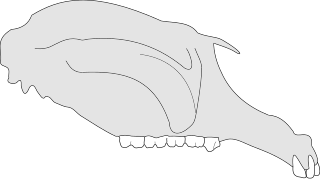
Tree-kangaroos are marsupials of the genus Dendrolagus, adapted for arboreal locomotion. They inhabit the tropical rainforests of New Guinea and far northeastern Queensland, along with some of the islands in the region. All tree-kangaroos are considered threatened due to hunting and habitat destruction. They are the only true arboreal macropods.

Macropodidae is a family of marsupials that includes kangaroos, wallabies, tree-kangaroos, wallaroos, pademelons, quokkas, and several other groups. These genera are allied to the suborder Macropodiformes, containing other macropods, and are native to the Australian continent, New Guinea and nearby islands.

The order Peramelemorphia includes the bandicoots and bilbies. All members of the order are endemic to Australia-New Guinea and most have the characteristic bandicoot shape: a plump, arch-backed body with a long, delicately tapering snout, very large upright ears, relatively long, thin legs, and a thin tail. Their size varies from about 140 grams up to 4 kilograms, but most species are about one kilogram.

Pademelons are small marsupials in the genus Thylogale, found in Australia and New Guinea. They are some of the smallest members of the macropod family, which includes the similar-looking but larger kangaroos and wallabies. Pademelons are distinguished by their small size and their short, thick, and sparsely-haired tails. Like most other marsupials, they carry their young in a pouch.

The dingiso, also known as the bondegezou or bakaga, is an endangered, long-tailed marsupial found only in mountain forests on the west of the island of New Guinea. It is a species of tree-kangaroo, which are mammals native to Australia and New Guinea that feed on leaves or other plant matter. It belongs to the macropodid family (Macropodidae) with kangaroos, and carries its young in a pouch like most other marsupials. Though sacred to the local Moni people, it is still threatened by hunting and habitat loss.
A tautonym is a scientific name of a species in which both parts of the name have the same spelling, such as Rattus rattus. The first part of the name is the name of the genus and the second part is referred to as the specific epithet in the International Code of Nomenclature for algae, fungi, and plants and the specific name in the International Code of Zoological Nomenclature.

Sthenurinae is a subfamily within the marsupial family Macropodidae, known as short-faced kangaroos or sthenurine kangaroos. No members of this subfamily are extant today, with all becoming extinct by the late Pleistocene. Procoptodon goliah, the largest macropodid known to have existed, was a sthenurine kangaroo, but sthenurines occurred in a range of sizes, with Procoptodon gilli being the smallest at the size of a small wallaby.

Palorchestes is an extinct genus of large terrestrial, herbivorous Australian marsupial of the family Palorchestidae, living from the Miocene through to the Late Pleistocene. Like other palorchestids, it had highly retracted nasal region suggesting that it had a prehensile lip, as well as highly unusual clawed forelimbs that were used to grasp vegetation.

The Macropodiformes, also known as macropods, are one of the three suborders of the large marsupial order Diprotodontia. They may in fact be nested within one of the suborders, Phalangeriformes. Kangaroos, wallabies and allies, bettongs, potoroos and rat kangaroos are all members of this suborder.

Protemnodon is an extinct genus of megafaunal macropodids that existed in Australia, Tasmania, and New Guinea in the Pliocene and Pleistocene. Members of this genus are also called giant kangaroos.

The lowlands tree-kangaroo, also spelt "lowland," is a long-tailed, furry, bear-like mammal found only in lowland tropical rainforests on the island of New Guinea. It is a species of tree-kangaroo, which are tree-dwelling animals that feed on leaves or other plant matter. Tree-kangaroos are in the macropod family (Macropodidae) with kangaroos, and like other marsupials they carry their young in a pouch. The lowlands tree-kangaroo is threatened by habitat loss.

Propleopus is an extinct genus of marsupials. Three species are known: P. chillagoensis from the Plio-Pleistocene, and P. oscillans and P. wellingtonensis from the Pleistocene. In contrast to most other kangaroos, and similar to their small extant relative, the musky rat-kangaroo, they were probably omnivorous.

Macropodinae is a subfamily of marsupials in the family Macropodidae, which includes the kangaroos, wallabies, and related species. The subfamily includes about ten genera and at least 51 species. It includes all living members of the Macropodidae except for the banded hare-wallaby, the only surviving member of the subfamily Lagostrophinae.
The Macropodidae are an extant family of marsupial with the distinction of the ability to move bipedally on the hind legs, sometimes by jumping, as well as quadrupedally. They are herbivores, but some fossil genera like Ekaltadeta are hypothesised to have been carnivores. The taxonomic affiliations within the family and with other groups of marsupials is still in flux. Macropodids are considered to be the most diverse group of marsupial herbivores ever to have evolved, and have been the subject of more phylogenetic studies than any other marsupial family.
Macropus pearsoni is an extinct Australian vertebrate species belonging to the family Macropodidae, and is in the same genus (Macropus) as extant kangaroos. M. pearsoni lived during the Pleistocene. It is known from fossil mandibles collected from Pleistocene beds from the Darling Downs in New South Wales, Lake Kanunka in northeastern South Australia, and the Cape York Peninsula. it reached a size similar to Macropus titan, which is a mass of 150 kg.

Notamacropus is a genus of small marsupials in the family Macropodidae, commonly known as wallabies. The term is derived from the Latin nota "stripe" and macropus "kangaroo", referencing the distinct facial stripe of many extant genus members and their phylogenetic relationship to other kangaroos.

The Wondiwoi tree-kangaroo is a critically endangered, bear-like mammal native to tropical mountain forests on the island of New Guinea in Western Papua. Elusive and rare, it was considered extinct until rediscovery in 2018. It is a species of tree-kangaroo, a group of long-tailed, bear-like animals native to Australia and New Guinea that mostly live in trees and feed on plant matter. Tree-kangaroos belong to the macropod family (Macropodidae) with kangaroos, and carry their young in a pouch like most other marsupials. The Wondiwoi tree-kangaroo is likely threatened by hunting, and is known only from remote mountains on the Wondiwoi Peninsula in northwest New Guinea.

Propalorchestes is a fossil genus of palorchestid marsupial that existed in Australia during the Miocene epoch.

Bohra is an extinct genus of macropod from the Plio-Pleistocene of Australia. It is closely related to modern tree kangaroos (Dendrolagus), and like them is thought to have had an arboreal lifestyle, with some species of Bohra substantially exceeding living tree kangaroos in size.

Congruus is an extinct genus of macropod known from the Late Pleistocene of Australia. There are two species, Congruus kitcheneri, which was originally described as a species of Wallabia, and Congruus congruus. Specimens are known from Mammoth Cave, Western Australia, the Thylacoleo Caves and the Naracoorte caves in South Australia. Potential material is also known from Eastern Australia. The morphology of the skull and limbs suggests that they were semi-arboreal browsers, moving slowly through trees, though they were larger than and not as specialised for climbing as living tree kangaroos. They are thought to be members of the tribe Macropodini, and close relatives of the extinct genus Protemnodon.
















